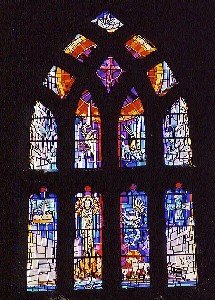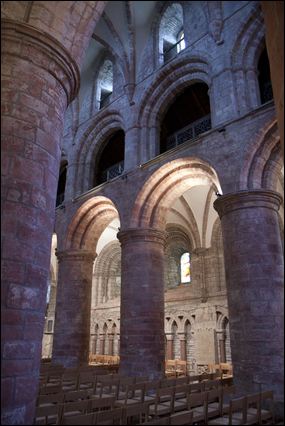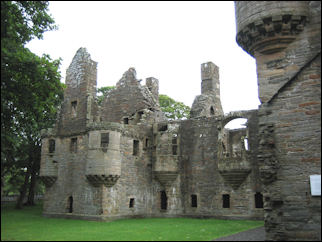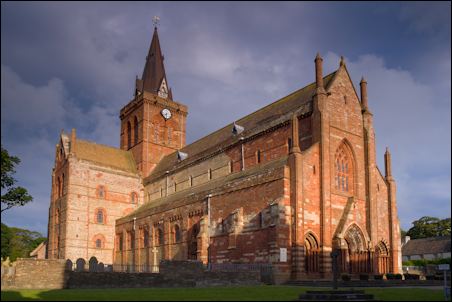Historic Kirkwall - Orkney
On this page: St Magnus Cathedral
Earl's Palace and Bishop's Palace
Tankerness House
![]()
The text below comes from the journal I kept when I was in Kirkwall in August 1993. It's a unique place. Visit it if you can.
St Magnus Cathedral
Its presence originates in events which occurred over eight hundred years ago during the time of Norse rule. Just after Easter 1117, Hakon tricked his cousin Magnus into meeting him on the island of Egilsay with a view to discussing the ownership of Orkney. As the peace-loving Magnus pleaded for his life and prayed for the soul of his murderer, Hakon ordered him to be struck down with an axe. Magnus was seen as a martyr and soon canonised when rumours of miracles spread. Before setting out to win possession of the islands, his nephew Rognvald vowed to build a church in Magnus' name if he was successful. It was duly started in 1137, under the expert eye of masons from Durham and the supervision of Rognvald's father.
|
Impressive when viewed from the exterior, this grand creation is even more magnificent inside. On entering the nave, I was first struck by the overall size and general structure of the building. Then as I began to walk around, I was taken in by the variety of things to see and the detail which has been lavished on them. Following extensions over the centuries, Romanesque, Transitional and Gothic styles all blend together in patterned arches, ogives and pillars made of red and yellow sandstone. Against the inner walls stand dozens of inscribed tombstones mostly dating from the seventeenth century and all seemingly carved with the skull and crossbones. Despite the cold air, the colours of the stone added a warmth to the atmosphere and as I made my way up the south aisle, the sun shone through the stained glass windows. In the choir, the remains of Magnus and Rognvald lie sealed within two pillars. After initially being buried on Birsay, Magnus' body was brought to Kirkwall once the cathedral was ready. His relics were found during renovation in 1919, a hundred years after the discovery of his nephew's skeleton. |
 Window in St Magnus Cathedral Image copyright Colin Palmer stock photo library - purchase prints and posters online |
In the far corners of the choir aisles, I came across the elaborate tombs of two Orkney-born explorers. John Rae, a doctor who joined the Hudson Bay Company in 1833, participated in many expeditions to the Arctic. Whilst William Balfour Baikie, a naval surgeon, navigated up the River Niger into 250 miles of uncharted territory.
Between them is the communion table which is overlooked by three golden statues set on a red background on the rear wall. Flanked by his father Kol and Bishop William the Old, Rognvald stands in the middle carrying a model of the cathedral as he designed it.
|
Heading down the north aisle, I was surprised to see a large painted statue of a Norse king. It turned out to be a representation of Saint Olaf which was presented by the Church of Norway to commemorate the cathedral's octocentenary. Further down is a small plaque in memory of the 833 sailors who died when HMS ROYAL OAK was torpedoed in Scapa Flow. In the north side of the nave hangs an example of a seventeenth century Mort Brod. This dark wooden board features a shrouded skeleton representing Death on one side and an inscription about the deceased on the other. Appropriately for a cathedral which sprang from the untimely passing of its patron saint, death is omnipresent here but not overwhelming. I completed another circuit of the interior, then sat quietly to one side. I gazed upwards and tried to imagine the figures who would have walked in the shadowy arcades that run around the nave. I stared at the intricacies of the arches and thought of the craftsmen who had laboured to create such elaborate carvings. I examined the patterned floor under my feet and wondered who had gone before me. In the wall opposite, my eyes fell on an aperture behind which lay blackness. From the guide book, I remembered reading of a dungeon where people were imprisoned as late as the eighteenth century. Marwick's Hole is situated between the south wall of the choir and the south transept chapel. Its presence is betrayed only by this small opening well above eye-level. Previously I must have walked past it without realising. |
 Photo © Tomas Skopal | Fotolia.com |
I went over for a closer inspection, but could see nothing other than darkness. Before moving to a seat in the choir, I looked at the ornate wooden doors and pondered over what lay behind them. By the marble font, I sat absorbed by sculpted faces peering down on me. So many of the columns are decorated with strange human and animal heads. Finally, the time came for me to leave. From the serenity and mystery of the past, I stepped back into the outside world and the present.
Earl's Palace and Bishop's PalaceSet back from the road, across the grass and under a sprinkling of sycamores, sit the Renaissance ruins of the Earl's Palace. Oriel windows and decorations carved in the sandy coloured stonework gave glimpses of the former splendour of the residence. After paying the friendly custodian, I entered the dark corridors of the ground floor. The temperature dropped as steps led down to store rooms and cellars. In one, I stopped to watch a video outlining the history of Orkney. It is said that the name comes from orca since the early settlers mistook the islands for whales when they first saw them on the horizon. I also learned that Earl Patrick Stewart started his palace sometime between 1600 and 1607, but was unable to complete it before running into debt. Having taken over Orkney from his tyrant father, Mary Queen of Scots' half-brother, he continued to use the local people as slaves and was eventually executed for treason in 1615. |
 Copyright The Internet Guide to Scotland 2009 |
From there I went into the old kitchen and then up the main staircase to the first floor. A stone hand basin was clearly visible in the antechamber to one of the Earl's apartments where he would no doubt have kept his visitors waiting before granting them an audience. In several rooms, water closets had been built into recesses in the walls.
On entering the great hall with its elaborate fireplace and bay windows, I was surprised to hear disembodied voices and found that to the rear it overlooks the bowls club. It was hard to imagine the huge dining table where Earl Patrick would have sat almost four hundred years ago, surrounded by tapestries, trophies and servants, entertaining those he sought to impress.
As a party of Scandinavian teenagers began a noisy invasion, I crossed over the road to the mid-12th century Bishop's Palace which was constructed by Earl Rognvald to provide his friend William the Old with premises near the cathedral. In its day, the rectangular hall-house would have comprised apartments built over cellars, but now the wooden floors have all gone and the grey stone walls stand empty. It was here in 1263 that King Haakon of Norway died following his ill-fated attempt to prevent the Western Isles falling into Scottish hands at the Battle of Largs. Within three years his son had sold them to Alexander III ending four centuries of Norse rule. However, Orkney and Shetland were not relinquished for another two hundred years.
The palace itself was rebuilt in the 15th century and then restored by Bishop Reid in the mid-1500s when he added a strong round tower known as the "Moosie Toor". A dark, spiral staircase leads to the top and a bird's eye view of the cathedral. Standing cautiously back from the edge in a gusting wind, I found myself opposite its rose window, looking down on the graveyard. Over the rooftops on the western horizon, Wideford Hill, a gentle curved bump rising some 250 metres above sea level, was the only patch of high land to be seen.
Now in the care of Historic Environment Scotland. Open daily from April to October. Admission charge.
Tankerness House - The Orkney Museum
Originally built as two manses for members of the cathedral clergy, it was extended in 1574 and bought by the Baikies of Tankerness for use as a town house in the early seventeenth century. Following restoration in the 1960s, it is now a museum which charts the history of Orkney from its earliest inhabitants to the present day.
On the ground floor, displays explain what archaeological finds have revealed about life in the islands from agriculture to religion. Weapons, tools, jewellery, combs, pottery and even human remains provide a fascinating portrait of ancient times. Many artefacts are kept in perspex boxes with strict temperature and humidity controls. A series of rooms including stones carved with runic inscriptions tells the story of the Picts and Vikings. Upstairs the exhibits date from more recent times with paintings, family heirlooms and documents relating to local customs. A room is devoted to the Arctic explorer, John Rae.
Admission free. Open daily Monday - Saturday from 10am – 5pm all year (but closes for lunch October - April). Official web siteThe gardens to the rear of the house are an ideal spot to eat your sandwiches on a sunny day.

Suggested reading
If you are sightseeing around the islands, then an indispensable tool is the Leisure and Tourist Map for Orkney and Shetland which pinpoints well over 100 important places to see and has a gazetteer with a short description of each.

|
Orkney
Lovely colour guide with over 100 pages of photos devoted to these amazing islands. Covers local heritage and culture, ancient monuments, history of settlement, nature and the landscape, places to visit, etc. Second edition published 2007. Even if you don't get chance to buy it before you go, you will certainly want a copy for a souvenir when you have visited! Order online from Amazon.co.uk (commission link) Another useful one of the Pevensey island guide series covers Shetland. |
|
|
Monuments of Orkney: A Visitor's Guide (Explore Scottish Monuments)
Published in 2012. In this extensively illustrated guide, Orkney-based archaeologist Caroline Wickham-Jones introduces more than 60 monuments in concise and accessible terms, set in context by a brief history of the islands. A site location directory is also included. Amazon US - Amazon UK (commission links) |
|
|
Orkney: A Historical Guide Paperback
Published in 2015. Caroline Wickham-Jones, whow has worked extensively on Orcadian sites for many years, introduces the history of the islands and provides a detailed survey of the principal places and sites of historic interest. Amazon US - Amazon UK (commission links) |

|
Orkney
Written by well-known archaeologist, Anna Ritchie, this 163-page book is part of the excellent Exploring Scotland's Heritage series and is well worth having if you want all the details on the ancient monuments here. Amazon UK |

|
The Islands of Orkney
Lovely hardcover book containing over 300 pages written by Liv Kjorsvik Schei with photographs by Gunnie Moberg. Amazon UK (commission link) |
|
|
Stone Age Farmers Beside the Sea:
Scotland's Prehistoric Village of Skara Brae Lots of colour photos and a well-written text explaining what is known about this most unique archaeological site on mainland Orkney and the people who lived there. Makes history come alive! Amazon US - Amazon UK - Kindle edition - UK (commission links) |
|
A Guide to the Stone Circles of Britain, Ireland and Brittany
Comprehensive guide produced by famous expert Aubrey Burl. With maps, photos, descriptions, practical information on how to find them and what condition they are in, this is a very useful handbook for visiting prehistoric sites. Amazon US - Amazon UK (commission links) |
![]()
